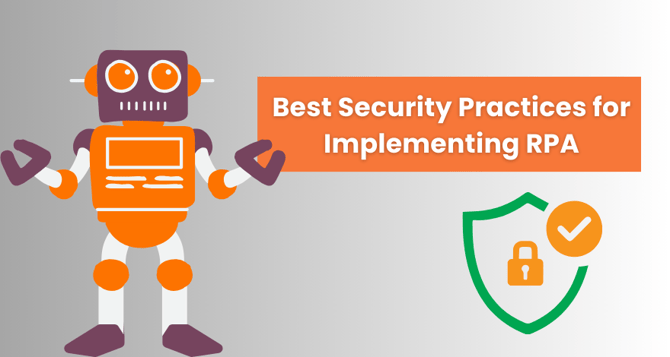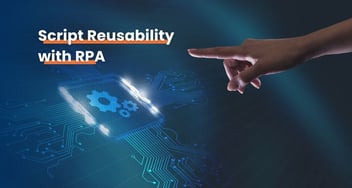Best Security Practices for Implementing RPA
By incorporating these security measures, businesses not only safeguard sensitive data but also foster trust, performance, and sustained growth in their RPA implementations. Consistent adherence to these practices ensures a fortified defense against evolving cyber threats.

Robotic Process Automation is a technique where the repetitive work of humans is automated and sometimes it includes transferring data from one place to another, so it's important to take care of that data, data security is supposed to be the priority in every software automation.
RPA uses data encryption to make data utilization more secure. This stops system invasions from hackers and imposters. RPA Security is one of the best practices while implementing RPA in any organization. To prevent system flaws that could lead to breaches and increase vulnerability to attacks, it is crucial to apply RPA best practices.
What Are RPA's Security Risks?
The two main risks related to RPA are data leakage and theft. If proper security procedures are not in place, sensitive data, such as:
- RPA bot passwords.
- Consumer data handled by RPA may be exposed to attackers.
RPA passwords are frequently traded for them to be reused. When these accounts and passwords are left unprotected, a cyber attacker may intercept them, use them to escalate privileges and transfer them laterally to get access to sensitive networks, software, and data.

If someone has access to administrative privileges can also find sensitive information, so always make sure of the administrator's access to platforms. However, there are other risk mitigation strategies, such as the appropriate governance and security measures described in this blog, that may keep your RPA systems completely protected from threats, including tailgating attacks.
How to Secure the Digital Workforce
One of the most significant threats to an organization is exposing its internal network or services to the Internet. When exposed, threat actors are easily able to spy on your traffic, steal data, or compromise your network.-
Ensure Accountability for bot Actions
-
- Bots mimic human actions, so while developing, developers should always keep the log file for bot actions so that records will be maintained to detect any unauthorized accesses and use APIs to access third-party portals.
- Make sure while data is transferred to the database it is supposed to be in encrypted form.
-
Analyze all the Risks in the Project before Developing
-
- Analyze the process before developing, and take care of all the malware attacks that can take place beforehand.
- While using 3rd party API in the RPA processes, make sure the data is coming from trusted HTTPS sources & proper authentication methods are used.
-
Minimize the Attack Surface Area
- Minimize the remote logging, server machines should be accessible to only a few main authorities.
- Strongly protected firewall in the servers.
Enhance Data Encryption with VPN
-
- Protect remote connections and sensitive data transfers by using ExpressVPN for PC. It provides an additional layer of encryption, ensuring confidential information remains secure from external threats. Additionally, combining VPNs with residential proxies can enhance security by masking IP addresses and ensuring uninterrupted access to geographically restricted services. This is essential when RPA tools interact with external networks or cloud services.
-
Don’t Trust Services
- Choose the RPA tool wisely. Some legacy tools like uipath, blue prism, and Automation Anywhere are security-certified (ISO/IEC 27001). Data will always be in encrypted form.
- Use Veracode software to analyze Tools scan flaws and get actionable source code analysis results.
-
Avoid Hard Coding Sensitive data/credentials in the Process
-
- Avoid the hard-coded values in RPA processes, the whole logic should be dynamic, and no static value should be passed in the code. Like taking passwords from the secure vault apps should be in encrypted forms.
- A process should be made in the form like it’s not logging sensitive information in log files, like passwords and other sensitive information.
-
Protect Log Integrity
- Every step of the process should be logged in a log file. This step will come when the malware attack has taken place. There will be autodetection of unauthorized activities at runtime and the process owner will also be notified.
- Uses Kibana and other analyzing tools for better security and better performance.
-
Good RPA Engineer
- A good quality RPA solution depends on how its code has been developed. RPA codes should be regularly pushed on it so that the record of the developer will be maintained as to who has pushed the latest code and the code should always follow the best practices of RPA.
Conclusion
Fuel businesses with the most secure automation solutions on the market. A secure RPA solution benefits businesses in data security. Businesses must install suitable cybersecurity safeguards since bots may need access to sensitive data. establishing version controls, audit logs, login vaults, governance systems, etc.
Want to Simplify RPA Maintenance with Script Reusability?
Get custom solutions, centralize updates, and reduce complexities. Let us streamline tasks with reusable scripts!
Establishing these protocols will enable RPA to handle security issues independently, enhancing robot productivity and lowering company risk.
When any organization applies secure RPA it gains trust in the market and improves performance which helps in the growth of organizations. As you can read in this article, how a secure RPA solution will provide more security to the business processes.



.png?width=344&height=101&name=Mask%20group%20(5).png)

















